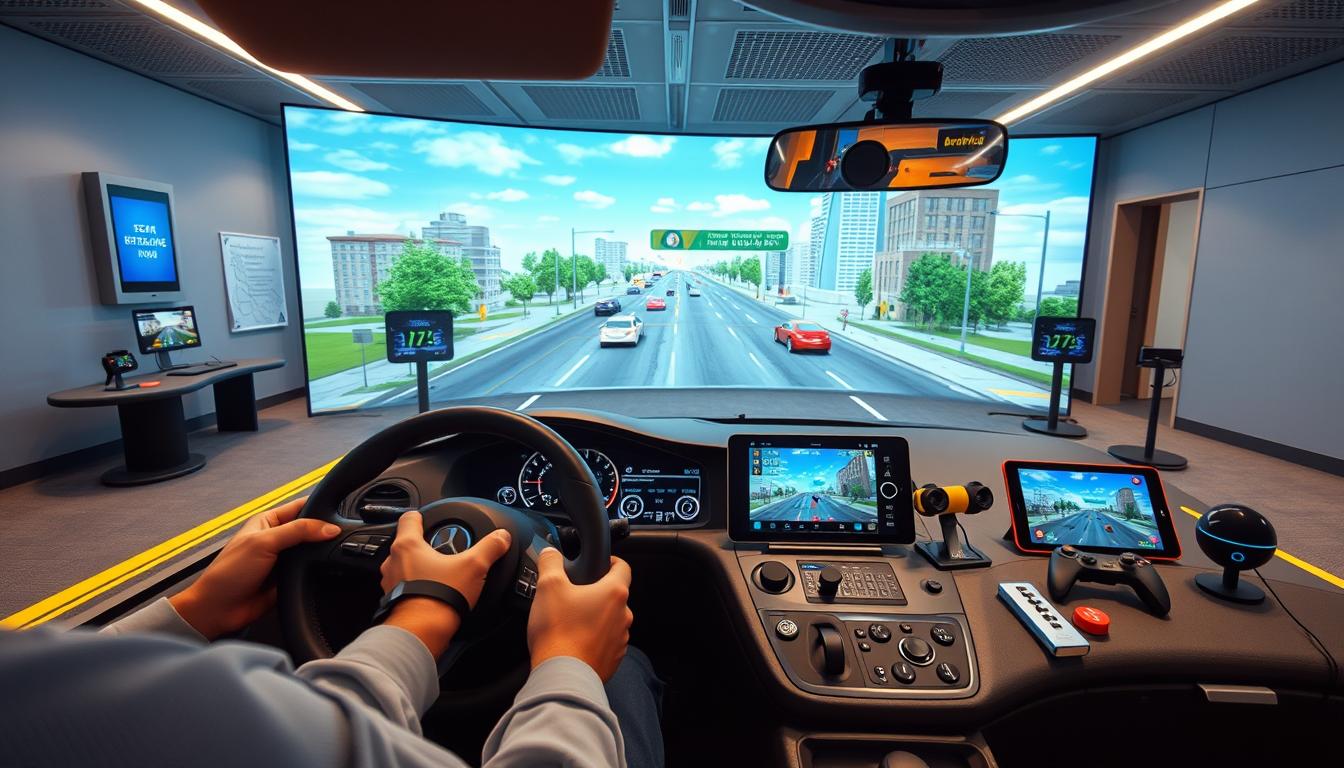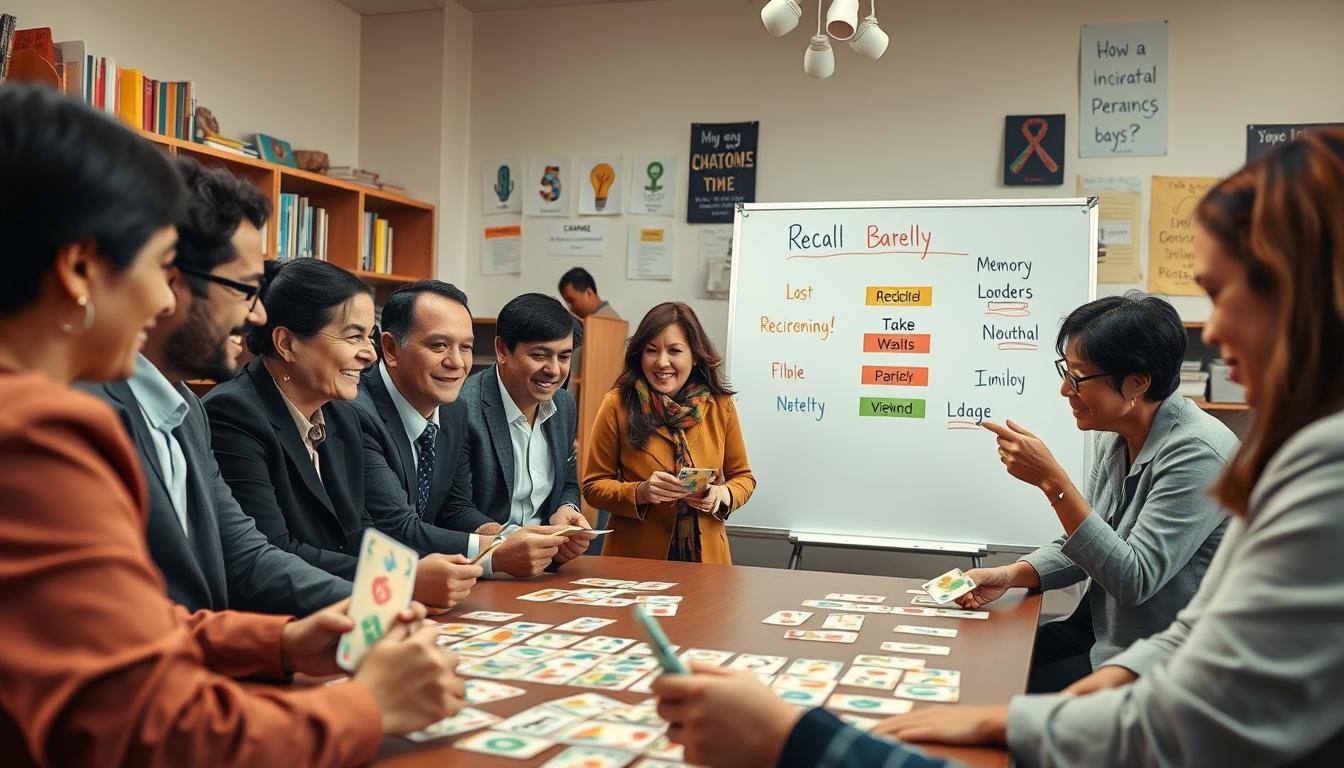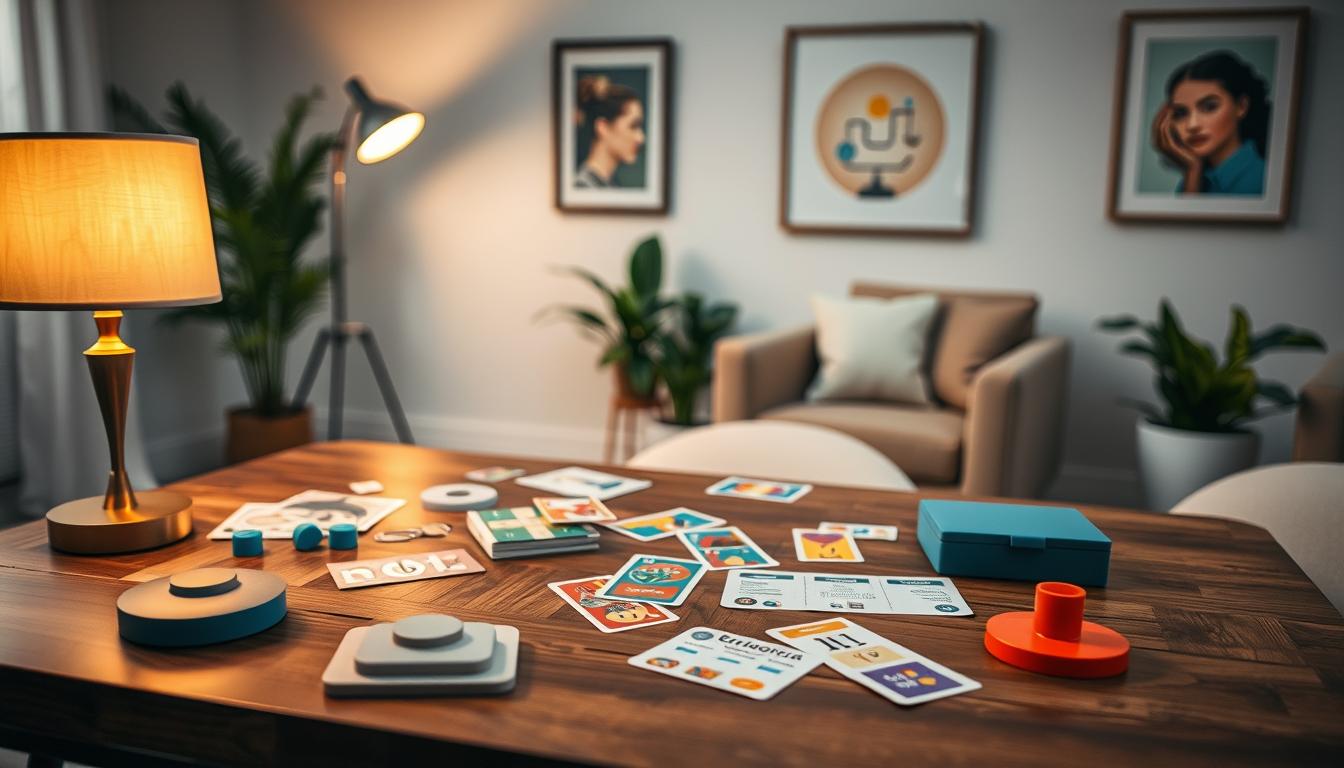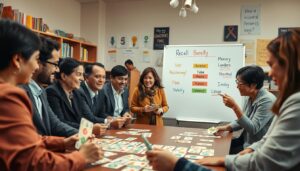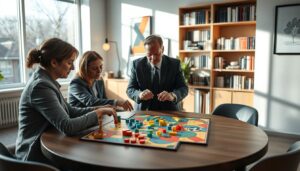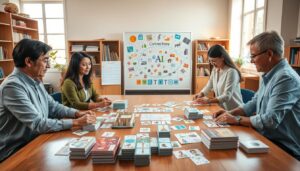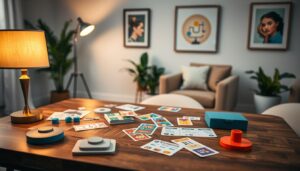Educational games to train spatial awareness in adults who drive regularly
Ever thought about how your spatial awareness affects your driving? In today’s world, staying safe on the road is key. For adults who drive a lot, knowing how to navigate better is crucial.
Games that boost spatial awareness are not just fun. They also help improve your brain’s ability to think and react. By getting better at seeing our surroundings, we can handle tricky situations on the road more easily.
Understanding Spatial Awareness
Spatial awareness is about knowing how objects relate to each other in space. It involves many skills like seeing things clearly, understanding distances, and knowing where you are. It’s key for driving, helping you make fast decisions and move safely.
Being good at spatial awareness means you can spot shapes, see how things fit together, and grasp three-dimensional space. It helps you deal with everyday tasks like parking and navigating through busy cities.
Everyday tasks rely on both cognitive skills and perception. People with strong spatial awareness solve problems better and stay safer while driving. Knowing about spatial awareness is important for better driving and navigating.

Importance of Spatial Perception in Driving
Spatial perception is key for safe driving. It helps drivers understand their surroundings well. This skill is vital for judging distances and making smart decisions on the road.
Drivers with good spatial perception can handle sudden changes better. They can react quickly to unexpected events like pedestrians stepping into the road or cars stopping suddenly.
Studies show that better spatial perception leads to fewer accidents. Drivers who are aware of their surroundings make safer choices. This skill is crucial for navigating through busy cities and highways.
By improving spatial perception, drivers become more confident. This confidence leads to safer driving for everyone on the road.
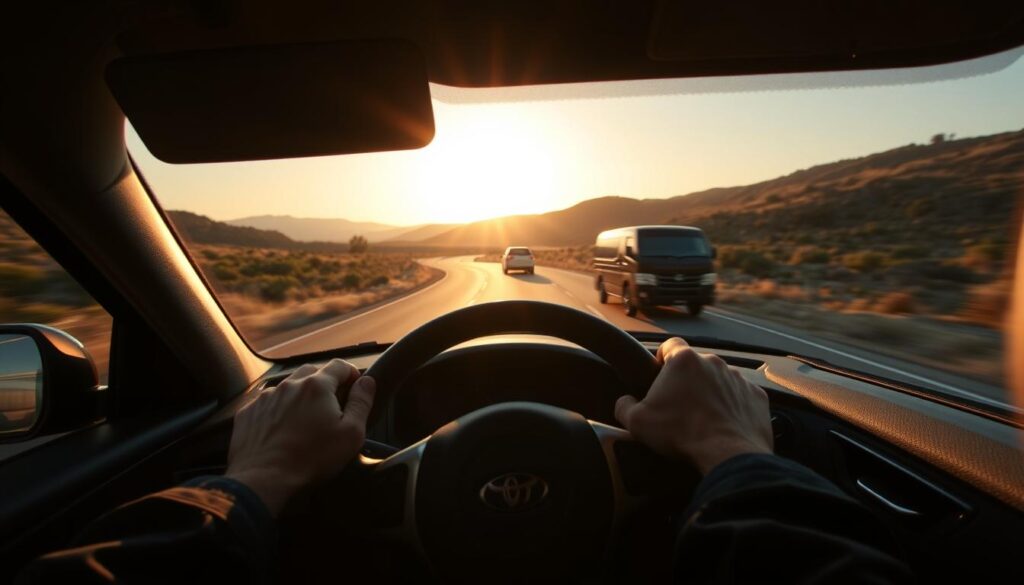
Benefits of Playing Educational Games
Playing educational games boosts our brain power in many ways. They help us remember things better, making it easier to solve problems. These games make learning fun and interactive, helping us get better at solving real-life challenges.
These games also make our brains work harder, creating stronger connections. Studies show they can improve our spatial skills, which is key for driving and everyday tasks. They make learning a fun, dynamic experience that sharpens our minds.
Adding educational games to our daily routine can greatly improve our brain skills. It combines fun with learning, helping us grow and develop continuously.
Types of Educational Games
Educational games are diverse, targeting key skills for driving. Memory games boost both working and long-term memory. They challenge players to recall information, improving mental agility for quick decisions on the road.
Visual games focus on spatial perception and navigation. They require users to understand and manipulate visual information. This is crucial for safe vehicle maneuvering. Strategy games also play a role, encouraging critical thinking and precise planning.
There’s a wide range of games to fit different learning styles. Mixing memory and visual games can improve spatial awareness. This enhances driving skills. Using these games makes learning fun and engaging.
Interactive Memory Games for Spatial Skills
Interactive memory games are a fun way to boost both working and long-term memory. They challenge players and help their minds grow. This is key for tasks like navigating streets while driving.
By doing exercises that improve memory, people can get better at spatial awareness. This is crucial for many daily activities.
Working Memory Enhancement
Working memory is vital for handling information quickly, like remembering a short list of directions. Memory games that improve working memory require fast recall and quick decisions. For instance, games that use ‘Chunking’ help players organize information better.
This makes it easier to remember and process important details while on the move.
Long-Term Memory Development
Long-term memory is also important for remembering familiar routes and landmarks. Games that focus on long-term memory help players practice and recognize information. For example, ‘Find the Right Match’ games help players match images or names with their locations.
This strengthens familiarity and helps in retaining information for confident driving.
Visual and Spatial Games to Boost Driving Skills
Visual games are a great way to improve spatial skills. They help people better understand their surroundings. Players learn to see complex figures and grasp three-dimensional relationships.
These games make players better at processing visual information. This is key for driving skills.
Engaging with Complex Figures
Complex figures are a big challenge for players. They need to figure out shapes and their position. Playing these games sharpens the ability to judge distances and angles.
Players get better at seeing things from different angles. This is important for safe driving.
Understanding 3D Spatial Relationships
Driving well means understanding space. Visual games help with this by simulating real-world environments. Players learn to see how things fit together in space.
Games like ‘Points of View’ and ‘Turn Around and Around’ help. They improve quick decision-making based on spatial awareness.
Digital Map Games for Spatial Reasoning
Digital map games like GeoGuessr and Minecraft are fun ways to improve your spatial reasoning and map reading skills. Players dive into interactive worlds where they must analyze their surroundings to make smart decisions. This type of gameplay boosts problem-solving and helps with navigation skills.
Popular Options: GeoGuessr and Minecraft
GeoGuessr takes players on a journey around the world, asking them to guess their location based on what they see. It’s a great way to learn about geography and culture. Minecraft, on the other hand, lets players explore and build in a 3D world. Both games make learning about maps fun and interactive.
Impact on Distance Estimation
Playing these games helps players get better at guessing distances. They learn to see space and scale, which is key for good navigation. By playing regularly, players get better at judging distances, which can help them drive safer and make better decisions.
| Game | Spatial Skills Developed | Estimation Accuracy |
|---|---|---|
| GeoGuessr | Location identification, map reading | High |
| Minecraft | 3D spatial relationships, creative building | Moderate |
Board Games That Train Spatial Skills
Board games are a fun way to improve spatial skills. They offer a hands-on experience in a social setting. Players use maps and plan strategies, which boosts their spatial awareness and navigation.
These games also promote teamwork and strategy. This makes them great for improving spatial reasoning together.
Here are some popular board games known for their effectiveness in training spatial skills:
| Board Game | Spatial Skills Developed | Cognitive Processes Enhanced |
|---|---|---|
| Carcassonne | Tile placement and territory management | Spatial reasoning, planning |
| Azul | Pattern recognition and tile arrangement | Visual-spatial skills, strategic thinking |
| Qwirkle | Color and shape matching | Problem solving, cognitive flexibility |
| Kanban: Driver’s Edition | Resource and space management | Logical reasoning, decision-making |
Playing these games, people tackle complex spatial challenges. The social aspect makes learning fun and effective. It shows that board games are not just for fun but also for improving important skills.
Spatial Perception Games: An Overview
Spatial perception games are key to improving driving skills. They come in many types, each aiming to boost spatial awareness. Knowing the different types helps find games that match your style and preferences.
The main types of spatial perception games are:
- Puzzle Games: These games test your ability to solve spatial puzzles and navigate complex spaces. Games like Tetris and Portal need both strategy and spatial thinking.
- 3D Modeling Games: Games like Minecraft or SketchUp let you work with 3D objects. They help you understand spatial relationships and dimensions.
- Navigation Games: These games improve mental mapping and direction. GeoGuessr, for example, puts you in real places, boosting your environmental awareness.
- Simulation Games: These games offer realistic driving and flying experiences. They require sharp spatial awareness to navigate virtual worlds well.
Playing these games makes learning fun and boosts spatial perception and cognitive skills. You can pick from many games to find the perfect match for your interests and needs.
How Map Games Improve Mental Navigation
Map games are key in boosting mental navigation skills. They challenge players to understand different types of spatial data. This leads to big improvements in thinking.
Playing map games makes you better at analyzing routes and recognizing landmarks. It also helps you guess distances. All these skills improve your spatial abilities.
Studies show that map games make your spatial memory and orientation better. These skills help you navigate in real life. They make driving easier and more natural.
Map games help you understand environments better. As you learn to navigate in games, you build a mental map. This helps you navigate in real life too.
Map games are a fun way to get better at navigating and driving. They make you more confident in different environments.
Combining Digital and Physical Games
Blending digital and physical games creates a rich learning space. It lets people enjoy both hands-on and tech-based activities. This mix boosts spatial awareness, helping adults learn to drive better.
Digital games offer quick feedback, which helps learning happen fast. Adding physical games brings real-world skills into play. This mix makes learning fun and effective.
Using both digital and physical games keeps learning exciting. It helps improve spatial skills and keeps players motivated. By trying different platforms, learners enhance their abilities and solidify what they’ve learned.
Creating a Consistent Gaming Routine
Setting up a gaming routine is key to boosting spatial awareness through games. Playing games every day sharpens your mind and makes learning fun, especially with friends.
Here are some tips for a good gaming routine:
- Choose a time each day for playing educational games.
- Play different games to improve various spatial skills.
- Keep track of your progress to see how far you’ve come.
Adding friends and family to your gaming routine can make it more fun. It turns practice into a team effort. Here’s how to make it social:
- Plan weekly game nights for everyone to join in.
- Start friendly competitions to keep things exciting.
- Share your wins to celebrate together.
Using Technology to Enhance Learning
Technology has changed how we learn about spatial awareness. Tools like AI and augmented reality make learning fun and personal. They help us remember what we learn and make training better.
AI and Augmented Reality Applications
AI helps make learning fit each person’s needs. It looks at what you know and changes what you learn. Augmented reality adds to this by making learning interactive and real.
This mix of tech and learning makes learning skills easier to get.
Benefits of Personalized Learning Tools
Personalized tools match learning to how each person learns best. They make learning active and engaging. This leads to faster learning and better understanding of spatial awareness.
These tools also give feedback right away. This helps learners see what they need to work on. With technology, learners can find paths that fit their goals.
Real-Life Applications of Enhanced Spatial Skills
Playing educational games can improve your spatial skills. This is very useful in everyday life, especially when driving. People who play these games become more aware of their surroundings. They also get better at navigating.
This boost in spatial skills is key for safe driving. It helps drivers judge distances better. This means they can handle tight spots and lane changes with ease.
Understanding space better is crucial, especially in busy cities or during heavy traffic. It helps with complex driving tasks that need sharp judgment.
Real-life examples show how important this is. For instance, when reversing into a parking spot or checking the distance between cars at intersections. The ability to see space well makes driving safer and more efficient.
Conclusion
Enhancing spatial awareness through games is key for adults who drive a lot. Games like interactive memory challenges and digital map simulations boost spatial skills. They also make driving better.
These games are great tools for improving how we see our surroundings. They help us navigate better. This makes driving safer and more efficient.
Playing these games daily is a smart move. It’s fun to play alone or with family and friends. It helps us feel more confident and make better driving choices.
In short, using games to improve spatial awareness is a smart way to get better at driving. As we get better, we’ll handle driving challenges more easily. This leads to safer and more efficient trips.
FAQ
What is spatial awareness?
Spatial awareness is knowing how objects relate to each other in space. It includes understanding distances and directions. It’s key for quick decisions and navigation, like when driving.
How do educational games enhance spatial awareness in adults?
Educational games boost memory, problem-solving, and spatial skills. They make learning fun and interactive. Regular play strengthens brain connections and improves spatial perception.
What types of educational games are effective for training spatial skills?
Good games include memory, visual-spatial, and strategy games. They focus on skills like remembering routes and understanding space.
Can you provide examples of memory games that boost spatial skills?
‘Chunking’ and ‘Find the Right Match’ are great examples. They test memory, which is crucial for driving and recalling routes.
How do visual and spatial games improve driving capabilities?
These games enhance visual processing and three-dimensional understanding. They’re vital for judging distances and navigating while driving.
What are some popular digital map games that improve spatial reasoning?
Games like GeoGuessr and Minecraft improve spatial reasoning. They require analyzing data and making strategic decisions, boosting problem-solving skills.
How do board games assist in training spatial skills?
Board games offer tactile and interactive play. They often use maps to improve spatial awareness and navigation through teamwork and strategy.
What cognitive benefits do map games provide?
Map games enhance mental navigation. They improve spatial memory and orientation, essential for safe driving.
Why is it beneficial to combine digital and physical games?
Mixing digital and physical games offers a well-rounded learning experience. It engages different learning styles and reinforces spatial skills.
How can adults create a consistent gaming routine?
Adults can set up a daily gaming routine. Involving family and friends makes learning fun and boosts memory and spatial skills.
What role does technology play in enhancing spatial skill learning?
Technology, especially AI and augmented reality, offers personalized learning. It makes learning spatial skills engaging and effective.
How do enhanced spatial skills translate to real-life applications?
Better spatial awareness means safer driving and improved navigation. It shows the real-world value of cognitive training through games.
